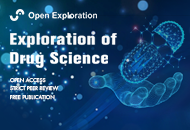6 results in Exploration of Drug Science
Latest
Sort by :
- Latest
- Most Viewed
- Most Downloaded
- Most Cited
Open Access
Review
Decoding vascular aging: implications for atherosclerosis progression and clinical intervention
Silumbwe Ceaser Wankumbu ... Ming Xu
Published: August 02, 2024 Explor Drug Sci. 2024;2:449–472

Open Access
Review
Metformin in COVID-19: a magical role beyond the hyperglycemia
Gaurav Kumar Chaubey ... Manoj Raje
Published: July 31, 2024 Explor Drug Sci. 2024;2:428–448

Open Access
Review
Natural products as anticancer agents and enhancing their efficacy by a mechanism-based precision approach
Stephen Safe
Published: July 30, 2024 Explor Drug Sci. 2024;2:408–427
This article belongs to the special issue Exploring Potential Drugs from Natural Products

Open Access
Original Article
From canonical to unique: extension of a lipophilicity scale of amino acids to non-standard residues
Antonio Viayna ... William J. Zamora
Published: July 30, 2024 Explor Drug Sci. 2024;2:389–407

Open Access
Original Article
Enhanced breast cancer cell targeting: RGD integrin ligand potentiates RWQWRWQWR’s cytotoxicity and inhibits migration
Andrea Barragán-Cárdenas ... Javier García-Castañeda
Published: July 19, 2024 Explor Drug Sci. 2024;2:369–388
This article belongs to the special issue Bioactive Peptides: Pioneering Innovations in Latin American Research

Open Access
Perspective
Plants and fungi metabolites as novel autophagy inducers and senescence inhibitors
Rivka Ofir
Published: July 01, 2024 Explor Drug Sci. 2024;2:361–368
This article belongs to the special issue Remedial benefits of natural products in inflammation and cancer

Journal Information